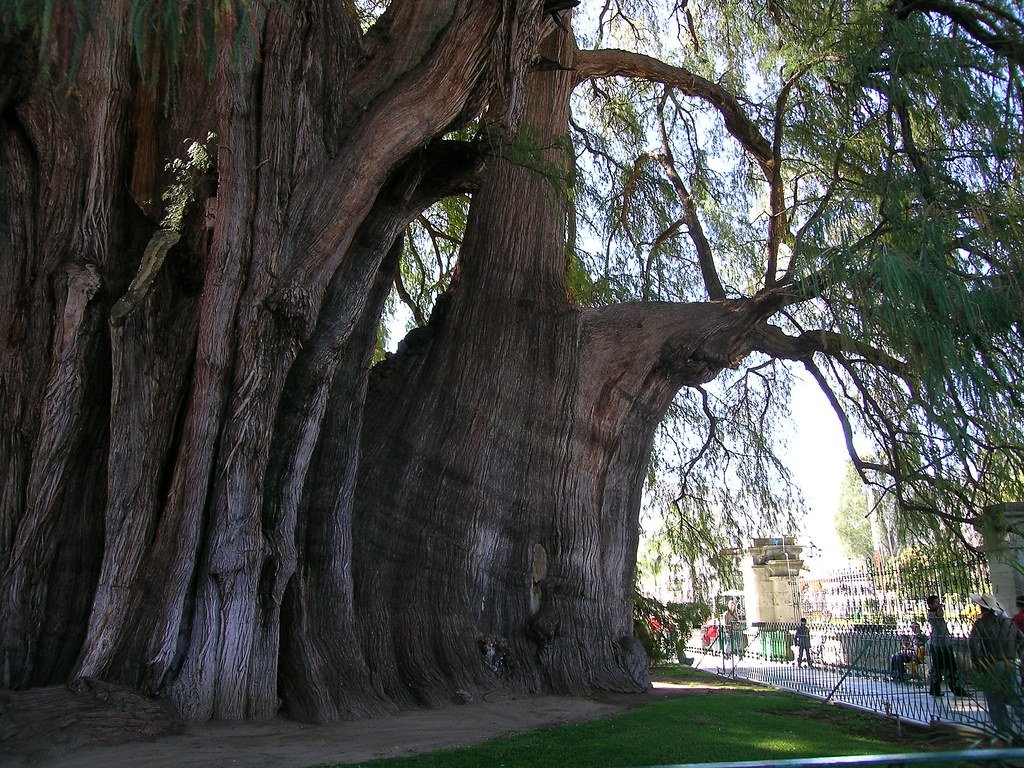Standing before El Árbol del Tule is like encountering a living cathedral, a monument carved not by human hands but by centuries of patience and growth. This massive Montezuma cypress rises from the dusty courtyard of a small church in Santa María del Tule, Oaxaca, Mexico, its trunk so wide that it would take more than 30 people holding hands to encircle it completely. For over 1,400 years, this gentle giant has witnessed the rise and fall of civilizations, weathered countless storms, and continues to baffle scientists with questions about its true age and mysterious origins.
The Giant That Defies Measurement
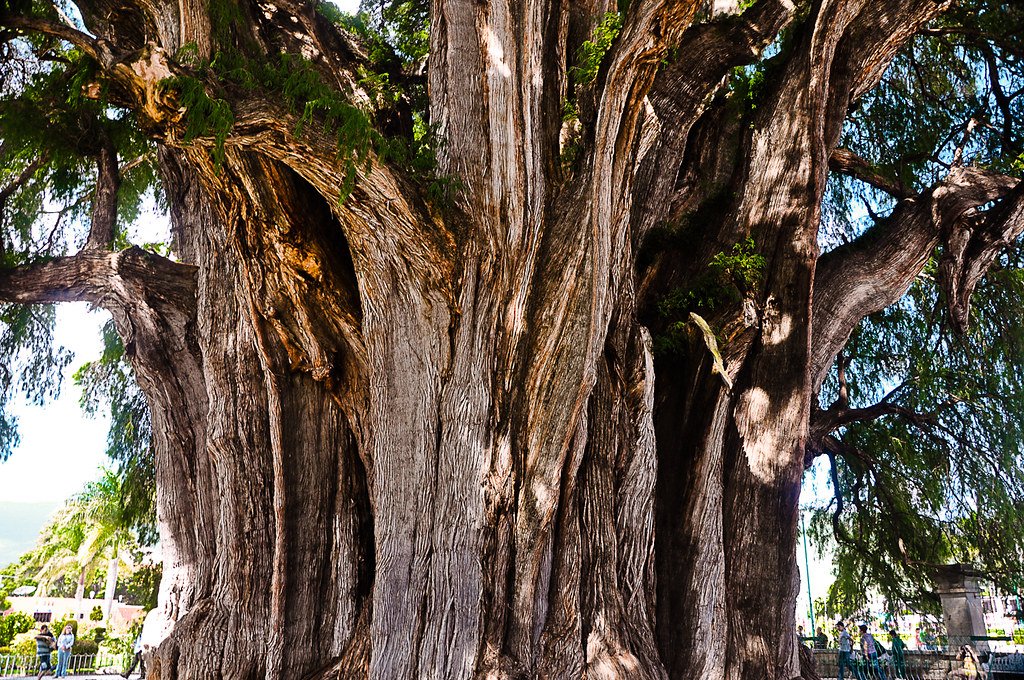
When you first glimpse El Tule through the church gates, your brain struggles to process what you’re seeing. The trunk stretches 36 feet in diameter – that’s wider than a standard city bus is long. Standing at roughly 116 feet tall, this isn’t the world’s tallest tree, but it claims the title of having the largest trunk circumference of any tree on Earth. The numbers tell only part of the story though, because seeing this botanical behemoth in person triggers something primal, a reminder of just how small we are in nature’s grand design.
Local guides love to point out that the tree’s circumference measures approximately 137 feet around its base. To put that in perspective, you could park three large RVs end-to-end and they wouldn’t span the tree’s width. The sheer mass of living wood before you represents thousands of tons of organic matter, all sustained by an intricate network of roots that likely extends far beyond what anyone has ever mapped.
What makes these measurements even more remarkable is that they’re constantly changing, albeit slowly. The tree continues to grow, adding microscopic layers each year, defying the typical growth patterns scientists expect from ancient trees. Most trees this old show dramatically slowed growth rates, yet El Tule seems to maintain a youthful vigor that puzzles botanists worldwide.
The trunk itself isn’t perfectly round but rather undulates with deep grooves and massive buttresses that create natural alcoves. These formations have sparked countless local legends and continue to provide shade for visitors who need a moment to process the magnitude of what they’re witnessing.
A Living Timeline of Human History
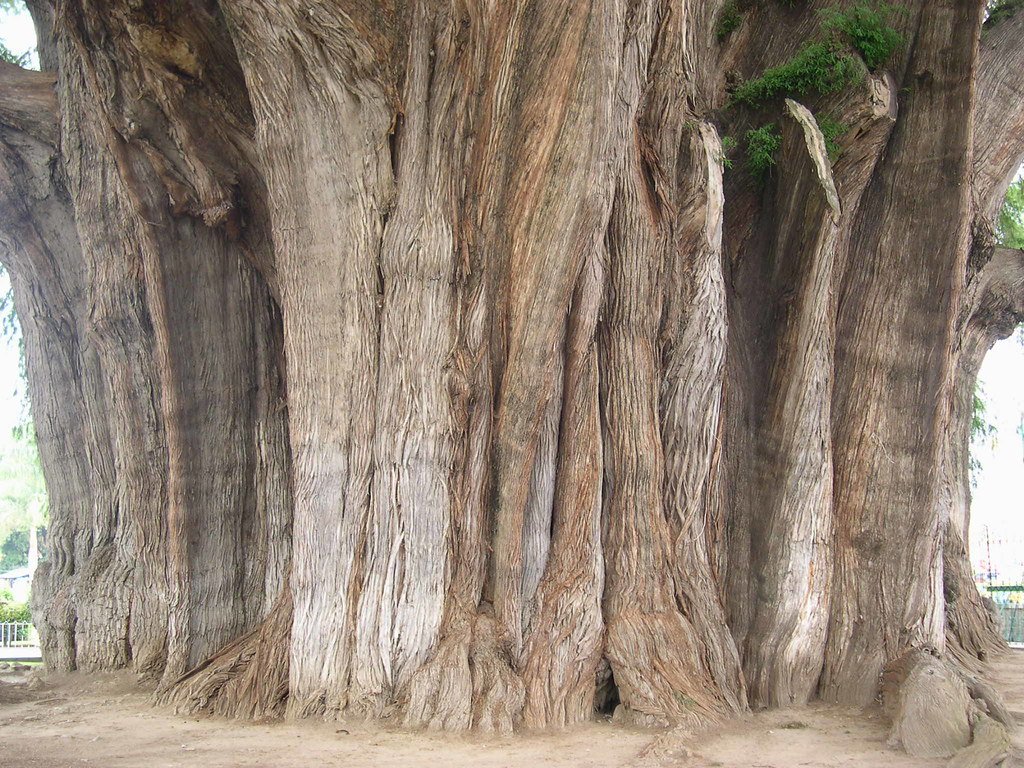
Radiocarbon dating and tree ring analysis suggest El Tule began its life sometime between 1,200 and 1,600 years ago, making it a contemporary of the fall of the Roman Empire. While European civilizations crumbled and reformed, this tree was already establishing the massive root system that would eventually support its incredible girth. The Zapotec people, who dominated this region long before Spanish colonization, likely revered this tree as sacred, incorporating it into their spiritual practices and daily life.
By the time Spanish conquistadors arrived in the 16th century, El Tule was already an ancient giant, probably appearing much as it does today. Colonial records mention the tree as a landmark, and Spanish missionaries built the small church of Santa María del Tule nearby, perhaps recognizing that this natural wonder drew people from across the region. The church and tree have coexisted for centuries, creating a unique blend of natural and human-made sacred space.
Throughout Mexico’s tumultuous history – including independence wars, revolutions, and modernization – El Tule has remained a constant. Local families have passed down stories spanning generations, with grandparents telling children about the same tree their own grandparents once climbed. This continuity creates an almost mystical connection between past and present, making visitors feel like they’re touching a living piece of history.
The tree has survived droughts that killed smaller plants, floods that reshaped the landscape, and even earthquakes that toppled buildings. Its resilience speaks to an adaptive capacity that scientists are only beginning to understand, suggesting that some of nature’s greatest survivors possess secrets we haven’t yet unlocked.
The Science Behind the Spectacular Growth

Montezuma cypresses, scientifically known as Taxodium mucronatum, are naturally long-lived trees, but El Tule represents an extreme example even within its species. These trees are semi-aquatic, preferring areas with high water tables, which explains why El Tule thrives in its current location near underground water sources. The consistent moisture availability has likely contributed to its exceptional size, providing the resources needed for continuous growth over more than a millennium.
The tree’s cellular structure reveals fascinating adaptations that enable such longevity. Unlike many tree species that develop heart rot or structural weaknesses with age, Montezuma cypresses produce natural preservatives in their wood that resist decay. This biological innovation allows them to maintain structural integrity even as they reach massive proportions, essentially engineering themselves to support their own incredible weight.
Recent studies using ground-penetrating radar have revealed that El Tule’s root system extends much further than previously imagined, creating an underground network that spans several city blocks. These roots don’t just anchor the tree; they form symbiotic relationships with soil microorganisms that help process nutrients and defend against pathogens. This underground ecosystem essentially turns the surrounding area into a biological support system for the giant above ground.
Photosynthesis at this scale presents unique challenges and solutions. The tree’s massive canopy contains millions of leaves, each one a tiny solar panel converting sunlight into energy. The logistics of moving water and nutrients from the roots to the highest branches requires a sophisticated internal transportation system that operates under tremendous pressure, like a biological skyscraper with its own elevator system.
What truly amazes scientists is the tree’s continued growth rate. Most ancient trees show signs of senescence, gradually slowing their growth as they age. El Tule, however, continues adding measurable girth each year, suggesting that it may not have reached its maximum potential size. This ongoing vitality challenges our understanding of plant aging and raises questions about what natural limits, if any, constrain tree growth.
Legends and Local Lore
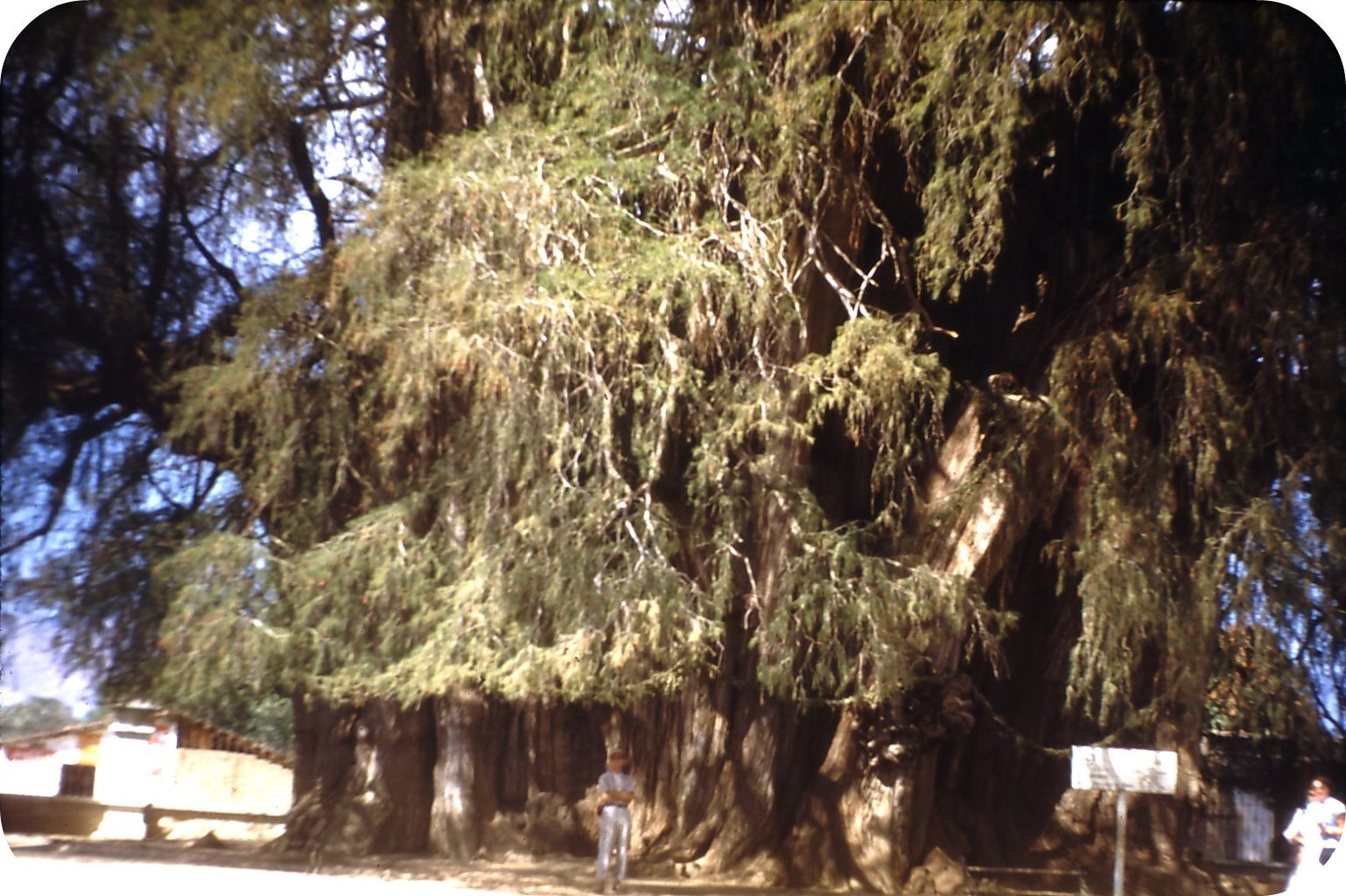
Local Zapotec traditions tell of Ehecatzin, the god of wind, who planted El Tule with his own hands as a gift to humanity. According to legend, the god wanted to create a tree so magnificent that it would serve as a meeting place for people from all walks of life, a living temple where earth touched sky. This origin story, passed down through oral tradition, reflects the deep spiritual significance the tree holds for indigenous communities.
Other local tales speak of the tree as a guardian spirit, protecting the town from natural disasters and bringing good fortune to those who approach it with respect. Elderly residents often recount stories of miraculous healings that occurred in the tree’s shade, though these accounts blend folklore with genuine reverence for the tree’s perceived mystical properties. Whether you believe in such supernatural elements or not, there’s no denying the sense of awe that El Tule inspires in most visitors.
The tree’s unusual trunk formations have spawned countless pareidolia experiences – the psychological phenomenon where people see familiar shapes in random patterns. Visitors regularly point out faces, animals, and mythical creatures seemingly carved into the bark’s natural contours. Local guides have catalogued dozens of these apparent figures, creating an informal game that delights children and adults alike.
One particularly persistent legend claims that El Tule isn’t a single tree but rather multiple trees that grew together over centuries, eventually fusing into one massive organism. While DNA analysis has largely debunked this theory, the legend persists, perhaps because it seems to explain how something so impossibly large could exist in our world.
The Mysterious DNA Question

Modern genetic analysis has revealed one of El Tule’s most intriguing mysteries: its DNA contains genetic markers that don’t perfectly match other Montezuma cypresses in the region. This genetic distinctiveness has led some scientists to speculate that the tree might represent a unique subspecies or even harbor genetic mutations that contributed to its exceptional size. The implications of these findings extend beyond mere botanical curiosity, potentially offering insights into how plants evolve to achieve extraordinary longevity and size.
Researchers have collected samples from trees across Mexico and Central America, trying to trace El Tule’s genetic lineage. The results suggest that while the tree is definitely a Montezuma cypress, it possesses certain genetic variations that might explain its unique characteristics. These variations could represent adaptations that occurred over centuries of environmental pressure, essentially making El Tule a one-of-a-kind evolutionary experiment.
The genetic mystery deepens when considering the tree’s reproductive history. Despite its age and size, El Tule continues to produce viable seeds, some of which have been successfully germinated and grown into healthy saplings. However, none of these offspring show signs of developing the same massive proportions as their parent, suggesting that size alone isn’t purely a genetic trait but rather the result of a perfect storm of genetic, environmental, and perhaps even chance factors.
Some scientists theorize that El Tule’s unique genetics might hold keys to understanding plant longevity and resilience, potentially offering insights that could help other tree species adapt to climate change. The tree’s ability to thrive for over a millennium while maintaining active growth could provide blueprints for developing more resilient forest ecosystems.
Climate Champion and Carbon Storage Powerhouse
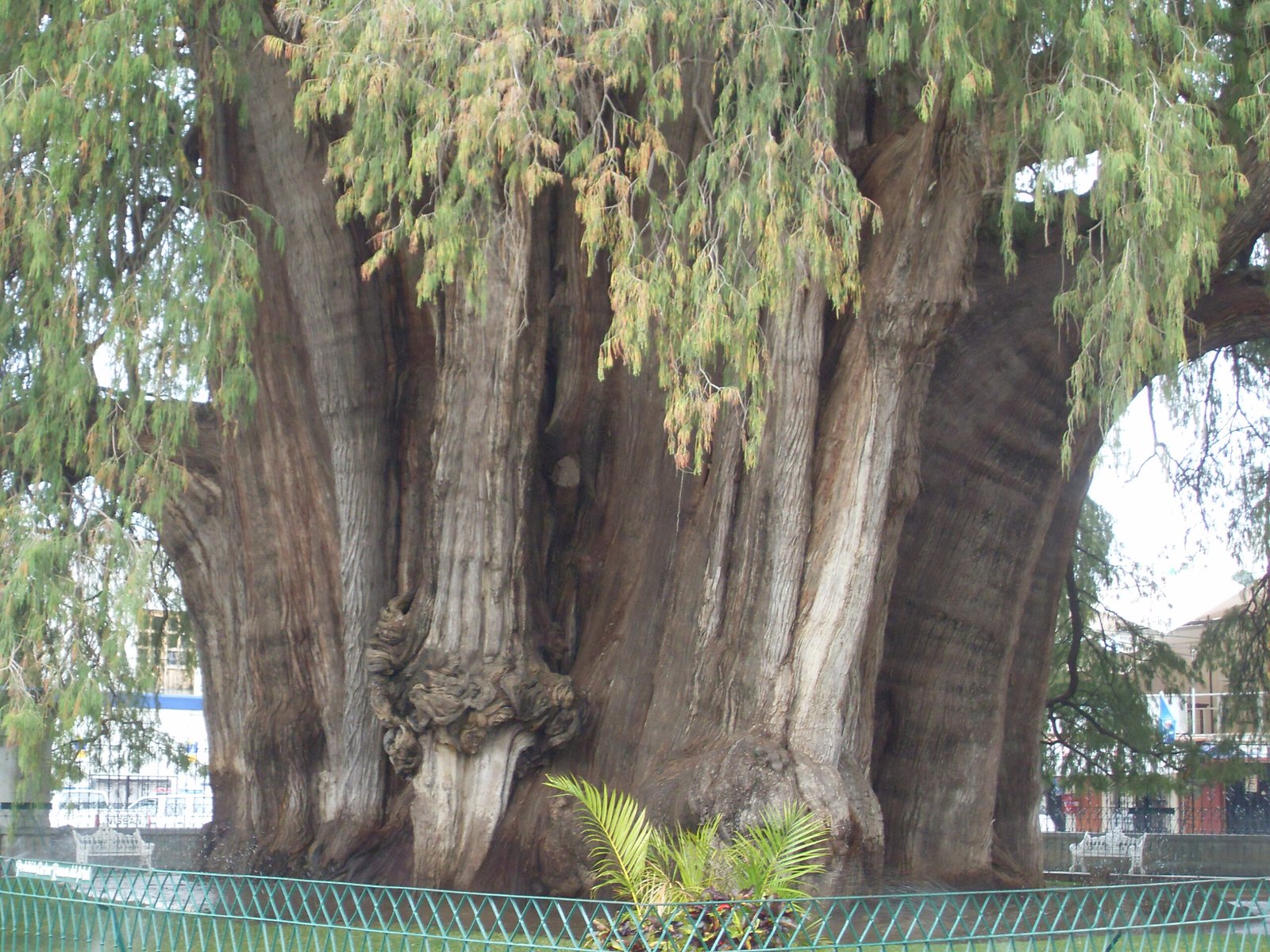
El Tule functions as a living carbon capture facility, sequestering massive amounts of carbon dioxide from the atmosphere throughout its long life. Scientists estimate that the tree has absorbed and stored several tons of carbon over its lifetime, making it a one-tree climate solution that has been working for centuries before humans even understood the concept of carbon sequestration. This natural carbon storage capacity represents decades of what modern industrial carbon capture systems struggle to achieve.
The tree’s massive leaf canopy processes enormous quantities of air daily, converting carbon dioxide into oxygen through photosynthesis on a scale that dwarfs most other individual plants. During peak growing season, El Tule produces enough oxygen to support the breathing needs of multiple families, essentially functioning as a biological air purification system for the entire surrounding area.
Beyond carbon storage, the tree creates its own microclimate, moderating temperatures in its immediate vicinity and providing crucial shade during Mexico’s intense summer heat. Local temperature measurements show that the area directly beneath El Tule’s canopy can be 10-15 degrees cooler than surrounding areas, creating a natural air conditioning system that has provided relief for countless generations of visitors.
The tree’s root system also plays a crucial role in water management, helping to prevent soil erosion and maintaining local water table stability. This underground network essentially acts as a natural water filtration and retention system, contributing to the overall ecological health of the region in ways that scientists are still discovering and documenting.
Conservation Challenges and Modern Threats

Despite surviving over a millennium, El Tule faces modern challenges that threaten its continued existence. Urban development around Santa María del Tule has altered natural water flow patterns, potentially affecting the underground water sources that have sustained the tree for centuries. Concrete roads and buildings create barriers that prevent rainwater from naturally percolating into the soil, forcing the tree’s roots to work harder to access the moisture they need.
Air pollution from nearby Oaxaca City poses another significant threat, as vehicle emissions and industrial pollutants can damage the tree’s leaves and interfere with photosynthesis. While El Tule has proven remarkably resilient, the cumulative effects of modern environmental stressors represent unprecedented challenges that the tree has never faced in its long history.
Tourism, while economically beneficial to the local community, also creates stress for the ancient giant. Thousands of visitors each year compact the soil around the tree’s base, potentially damaging shallow roots and affecting water absorption. Well-meaning tourists sometimes break off small branches as souvenirs, creating wounds that could potentially allow pathogens to enter the tree’s system.
Climate change presents perhaps the most serious long-term threat, as shifting precipitation patterns and rising temperatures could fundamentally alter the environmental conditions that have allowed El Tule to thrive. Conservation efforts now focus on understanding and mitigating these modern threats while preserving the tree for future generations to witness and study.
The Economic Impact of Ancient Wonder
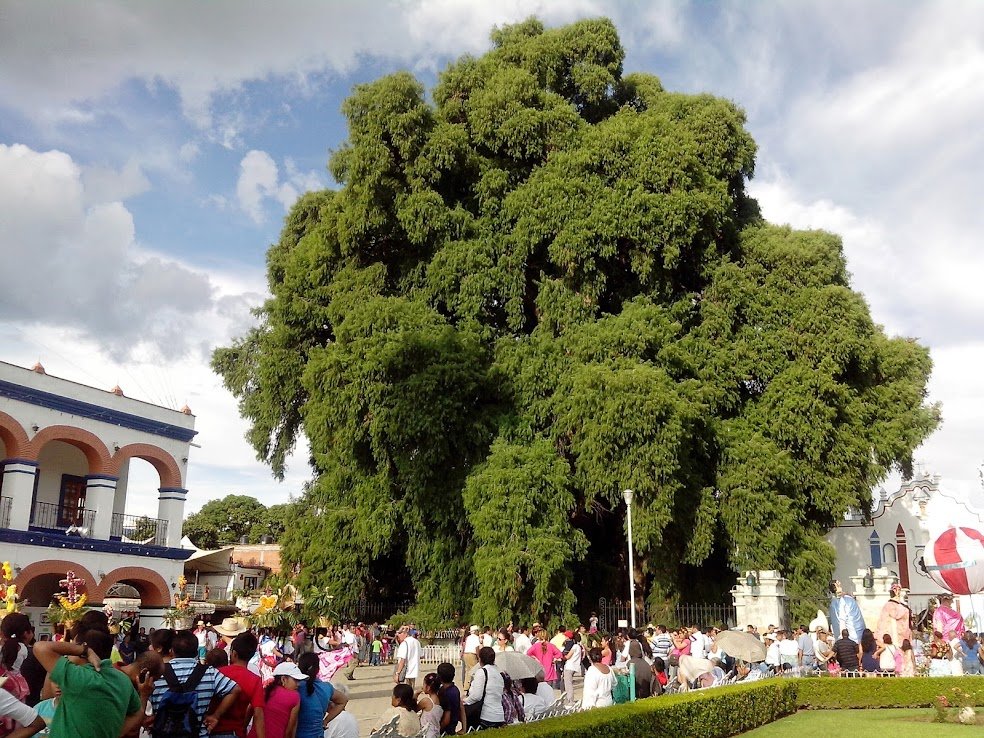
El Tule has become the economic backbone of Santa María del Tule, transforming a small agricultural community into a major tourist destination. Local businesses, from restaurants to souvenir shops, depend on the steady stream of visitors who come to witness the ancient giant. This economic transformation demonstrates how natural wonders can provide sustainable income for rural communities when properly managed and protected.
The Mexican government has recognized El Tule’s importance by designating it as a national monument, which brings both protection and funding for conservation efforts. This official status has enabled systematic research projects and conservation programs that might not otherwise be possible, creating a model for how countries can protect and study their natural heritage assets.
Local artisans have developed a thriving craft industry inspired by the tree, creating wood carvings, paintings, and textiles that celebrate El Tule’s majesty. These products provide additional income streams for community members while spreading awareness of the tree’s significance to visitors who take these mementos home to share with friends and family.
Educational tourism has emerged as another economic opportunity, with biology students, researchers, and nature enthusiasts traveling from around the world to study and experience El Tule firsthand. This specialized tourism brings higher-spending visitors who stay longer and contribute more to the local economy while fostering international scientific collaboration.
Comparing Giants: El Tule Among the World’s Largest Trees

While California’s giant sequoias claim fame for height and volume, and ancient bristlecone pines boast extreme age, El Tule holds the unique distinction of having the largest trunk circumference of any known tree on Earth. This makes direct comparisons challenging, as each tree species represents a different strategy for achieving botanical greatness. Where sequoias grow tall and bristlecones grow old, El Tule grows wide, creating its own category of natural wonder.
The famous General Sherman sequoia in California contains more total wood volume than El Tule, but its trunk diameter measures only about 27 feet compared to El Tule’s 36 feet. This difference might seem small on paper, but in reality, it represents thousands of cubic feet of additional wood and a dramatically different visual impact when standing before each tree.
Australia’s baobab trees share some similarities with El Tule, including massive trunk diameters and extreme longevity, but they achieve their proportions through a different growth strategy. Baobabs store water in their trunks, creating bottle-shaped profiles, while El Tule’s girth comes from solid wood growth, making it structurally more similar to temperate forest giants despite its tropical location.
What sets El Tule apart from other famous trees is its accessibility and cultural integration. Unlike many giant trees that exist in remote wilderness areas, El Tule sits in the heart of a living community, surrounded by daily human activity while maintaining its wild majesty. This unique setting creates opportunities for human-tree interaction that simply don’t exist with most other botanical giants.
Scientific Research and Ongoing Studies

Researchers from universities across Mexico and internationally have made El Tule a focal point for studies on tree longevity, growth patterns, and environmental adaptation. Current research projects examine everything from the tree’s internal water transport systems to its relationship with soil microorganisms, creating a comprehensive picture of how such ancient giants function at the cellular and ecosystem levels.
Dendrochronology studies of El Tule’s growth rings have provided valuable data about historical climate patterns in the region, essentially turning the tree into a living weather station that has been recording environmental data for over a millennium. These records help scientists understand long-term climate trends and predict how current climate changes might affect the region’s ecosystem.
Advanced imaging techniques, including 3D laser scanning and ground-penetrating radar, have revealed the tree’s internal structure in unprecedented detail. These non-invasive methods allow scientists to assess the tree’s health, identify potential structural weaknesses, and monitor changes over time without causing any damage to this irreplaceable specimen.
Collaborative research projects now link El Tule studies with broader investigations into plant aging, carbon sequestration, and forest ecosystem dynamics. The data collected from this single tree contributes to our understanding of how forests function globally and how they might respond to future environmental challenges.
Genetic research continues to unlock secrets about the tree’s unique characteristics, with scientists hoping to identify specific genes or gene combinations that contribute to exceptional longevity and size. These findings could potentially be applied to conservation efforts for other endangered tree species or even to developing more resilient forest plantations.
Cultural Significance and Spiritual Connections
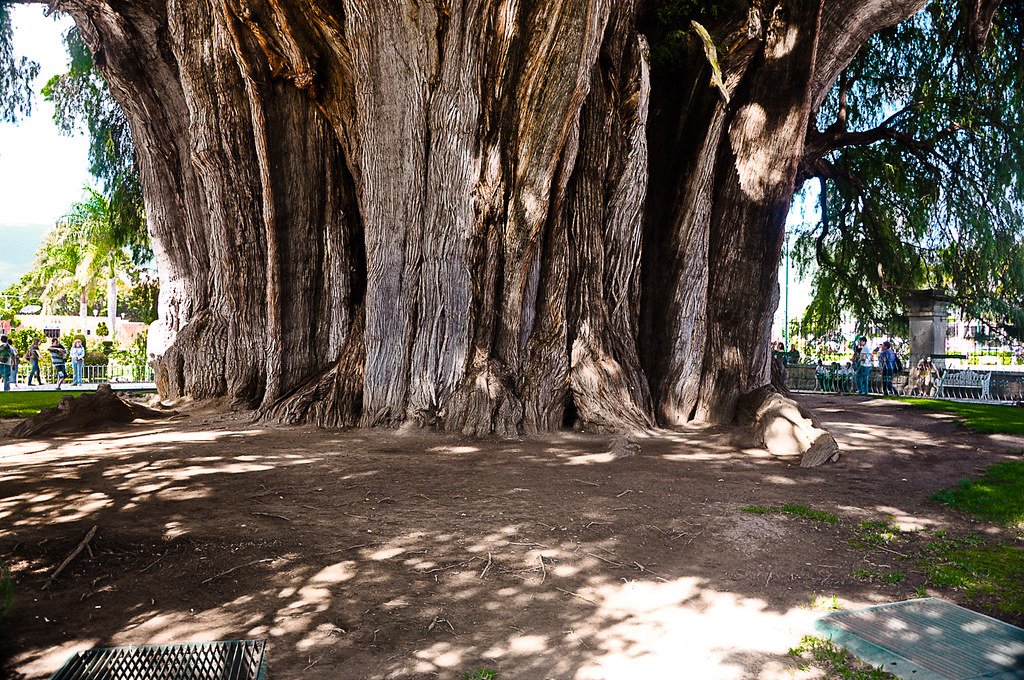
For many visitors, approaching El Tule triggers a profound spiritual experience that transcends religious or cultural boundaries. The tree’s immense age and size seem to connect people with something larger than themselves, creating moments of reflection and wonder that many describe as life-changing. This universal appeal suggests that certain natural phenomena speak to fundamental aspects of human consciousness and our relationship with the natural world.
Indigenous Zapotec communities continue to hold ceremonies at the tree, maintaining spiritual traditions that may be as old as the tree itself. These practices blend pre-Columbian beliefs with Catholic influences, creating a unique syncretic spirituality that honors both ancient wisdom and contemporary faith. Visitors often witness or participate in these ceremonies, gaining insight into how traditional cultures view their relationship with nature.
Artists, writers, and musicians have drawn inspiration from El Tule for generations, creating works that attempt to capture the tree’s majesty and meaning. Local museums display paintings, sculptures, and crafts inspired by the tree, while poets and authors have written extensively about the emotions and thoughts that the ancient giant evokes in those who encounter it.
The tree has become a symbol of Mexican natural heritage, appearing on currency, stamps, and official documents as a representation of the country’s commitment to preserving its natural wonders. This symbolic status elevates El Tule beyond mere botanical specimen to national treasure, embedding it in Mexico’s cultural identity and collective memory.
Photography and the Challenge of Capturing Immensity

Photographing El Tule presents unique challenges that have frustrated and inspired photographers for decades. The tree’s massive scale makes it nearly impossible to capture in a single frame that accurately conveys its true proportions, leading photographers to develop creative techniques for showing both detail and scope. Wide-angle lenses distort the tree’s shape, while telephoto shots lose the sense of scale that makes the tree so impressive in person.
Professional photographers often use human subjects in their compositions to provide scale reference, but even this technique struggles to convey the full impact of standing before such an enormous living organism. The best photographs often focus on specific details – the texture of ancient bark, the play of light through massive branches, or the expressions of awe on visitors’ faces – rather than attempting to capture the entire tree.
Social media has created new challenges and opportunities for documenting El Tule, with thousands of visitors sharing their own photographs and experiences online. This digital proliferation has made the tree famous worldwide while also highlighting the gap between photographic representation and physical reality – many people express surprise that the tree is even more impressive in person than in any photograph they’ve seen.
Time-lapse photography projects have begun documenting seasonal changes in El Tule’s appearance, creating visual records of how this ancient giant responds to changing weather patterns and environmental conditions. These projects require patience and dedication but provide valuable scientific data while creating stunning artistic documentation of the tree’s living dynamics.
The Future of El Tule
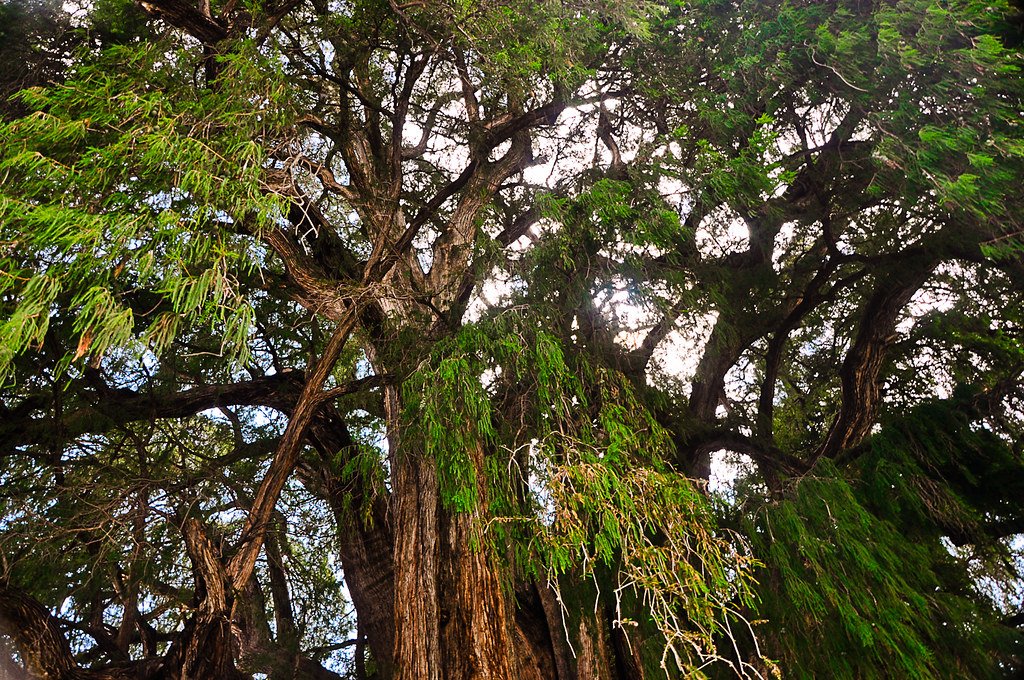
Conservation scientists have developed comprehensive management plans designed to protect El Tule for future generations while maintaining public access and scientific research opportunities. These plans address everything from soil management and water conservation to visitor impact mitigation and long-term health monitoring. The goal is to ensure that this natural wonder continues thriving for another thousand years or more.
Climate change adaptation strategies focus on helping El Tule cope with potentially changing environmental conditions, including modified precipitation patterns and rising temperatures. Researchers are developing contingency plans that could include supplemental watering systems, soil amendments, and protective measures against extreme weather events that climate change might bring to the region.
Educational programs centered around El Tule are expanding to reach broader audiences, from local schoolchildren to international researchers. These programs emphasize both the scientific importance of the tree and its cultural significance, creating a new generation of advocates for natural heritage preservation. Virtual reality and digital modeling technologies are being developed to allow people worldwide to experience El Tule without physically visiting the site.
Long-term research projects will continue monitoring El Tule’s growth, health, and environmental responses, creating an increasingly detailed picture of how ancient trees function and adapt over time. This ongoing research contributes to broader conservation efforts while ensuring that any changes in the tree’s condition are quickly detected and addressed.
International collaboration between Mexican institutions and research organizations worldwide has created a network of scientists dedicated to understanding and protecting El Tule. This collaborative approach ensures that the best available science and technology are applied to conserving this irreplaceable natural treasure for future generations to study and admire.
Visiting El Tule: A Transformative Experience
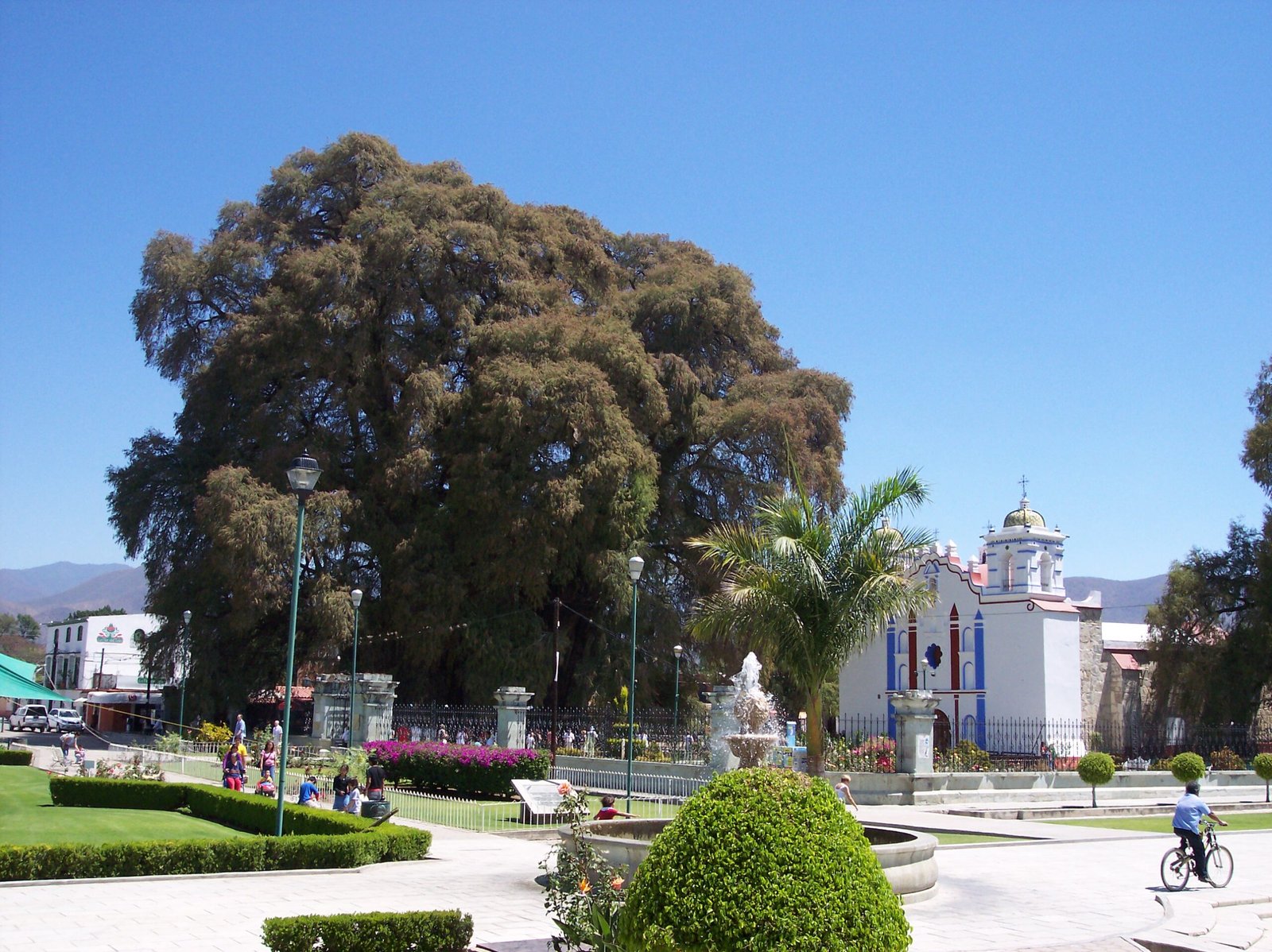
Planning a visit to El Tule requires more than just adding a destination to your travel itinerary; it demands preparation for an encounter that might fundamentally change how you perceive time, growth, and your place in the natural world.

